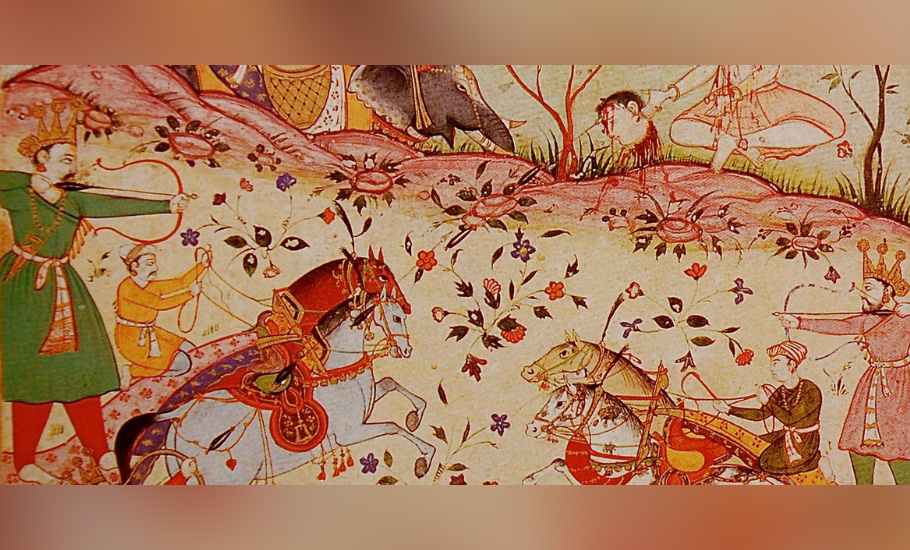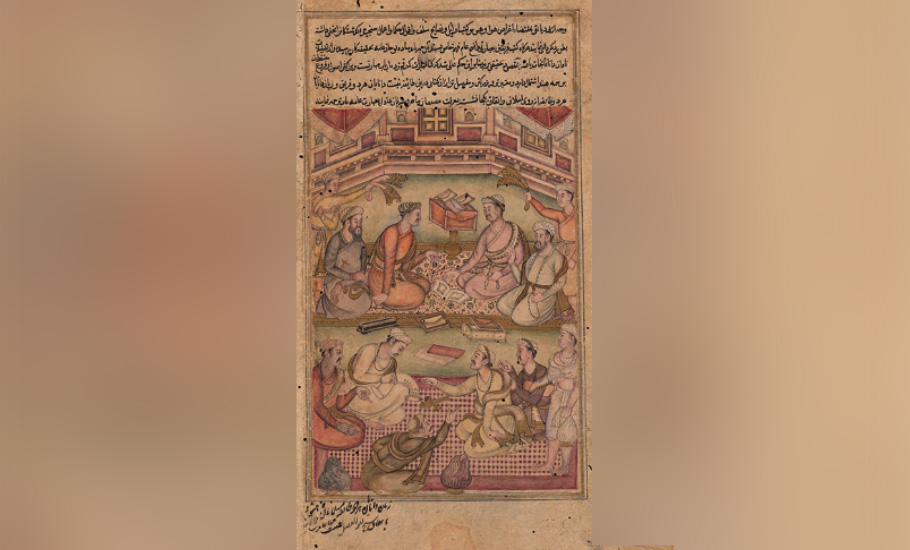
- Home
- News
- Analysis
- States
- Perspective
- Videos
- Education
- Entertainment
- Elections
- World Cup 2023
- Features
- Health
- Business
- Series
- Economy Series
- Earth Day
- Kashmir’s Frozen Turbulence
- India@75
- The legend of Ramjanmabhoomi
- Liberalisation@30
- How to tame a dragon
- Celebrating biodiversity
- Farm Matters
- 50 days of solitude
- Bringing Migrants Home
- Budget 2020
- Jharkhand Votes
- The Federal Investigates
- The Federal Impact
- Vanishing Sand
- Gandhi @ 150
- Andhra Today
- Field report
- Operation Gulmarg
- Pandemic @1 Mn in India
- The Federal Year-End
- The Zero Year
- Premium
- Science
- Brand studio
- Home
- NewsNews
- Analysis
- StatesStates
- PerspectivePerspective
- VideosVideos
- Entertainment
- ElectionsElections
- Sports
- Loading...
Sports - Features
- BusinessBusiness
- Premium
- Loading...
Premium

Translation and State: The Mahabharata in Akbar’s court

The translation of Mahabharata from Sanskrit into Persian in the 1580s was a remarkable event. After the Persian translation was finished, emperor Jalal ud-din Akbar named it the Razmnamah (Book of War) and ordered his adviser and courtier Abu al-Fazl ibn Mubarak to write a preface. In 1587, Abu al-Fazl, author of the Akbarnamah, completed his preface to the Persian translation of...
The translation of Mahabharata from Sanskrit into Persian in the 1580s was a remarkable event. After the Persian translation was finished, emperor Jalal ud-din Akbar named it the Razmnamah (Book of War) and ordered his adviser and courtier Abu al-Fazl ibn Mubarak to write a preface. In 1587, Abu al-Fazl, author of the Akbarnamah, completed his preface to the Persian translation of Mahabharata. The recently published Translation and State: The Mahabharata at the Mughal Court, edited by Michael Willis, is the first translation and detailed study of Abu al-Fazl’s preface to the Razmnamah.
Mughal emperor Akbar (1542-1605) is remembered as the first ruler to cross the social and religious borders of his kingdom.
Akbar’s zeal to bring different religious texts on a single platform paved the way for mythological texts to be translated and made accessible to non-Sanskrit speakers. To gain access to the literature of the non-Persian speaking world, scholars under Akbar’s patronage translated works from Latin, Hindi, Sanskrit and Greek into Persian.
“Under Akbar’s influence, the court developed a lively literary culture that explored the indigenous traditions of the Indian people, albeit through a Persianate lens. The stage was set when Persian was declared the official language of the court: members of the imperial bureaucracy were required to learn Persian, including a large number of Hindus who sought employment in the administration,” writes Razieh B Koshtely, one of the co-authors, in the first chapter of the Translation and State: The Mahabharata at the Mughal Court, which offers insights into manuscript practices at the Mughal court, the role a Persian version of the Mahabharata was meant to play, and the religious interactions that characterised 16th century India.

The team of researchers, which comprised Michael Willis, Razieh B Koshtely, Saarthak Singh, Vafa Movahedian and Muntazir Ali, chose the edition of Abu al-Fazl’s preface to the Razmnamah that was printed in Tehran between 1979 and 1981 for their study. Even though it was a landmark publication, the team soon found problems that led them back to the oldest manuscripts.
“A line of investigation was encouraged by the availability of these manuscripts in the British Library. These manuscripts gave fresh insights into the composition and structure of Abu al-Fazl’s preface and a better understanding of how writers and translators worked in 16th century India,” said Michael Willis, editor of Translation and State: The Mahabharata at the Mughal Court.
The book, according to Willis, emerged from Beyond Boundaries: Religion, Region, Language and the State, a project funded by the European Research Council. The project has been hosted in London by the British Museum, the British Library, and the School of Oriental and African Studies (University of London). The work was completed at the Royal Asiatic Society and published in collaboration with the Royal Asiatic Society of Great Britain and Ireland with support from the European Research Council. Abu al-Fazl’s preface has been edited and printed based on a number of manuscripts, among them copies in the British Library.
Abu al-Fazl’s preface is a unique document in the literary history of Mughal India, according to Michael Willis. “Its importance lies in the fact that it is the only Akbar-period introduction that is an integral part of the translation to which it refers. As the author of the preface, Abu al-Fazl describes the difficulties of dealing with textual sources and their interpretation.
He also uses the preface to reflect on the challenges he faced when charged with writing an introduction to a large work that was of particular interest to the king. Because of the king’s interest, he built his preface around his vision of kingship, embodied in the person of emperor Akbar. This gives the preface historical and political interest beyond its literary scope,” writes Willis in the introduction to the book.
The translation of the Mahabharata was part of a large cultural project and the most ambitious undertaking of the Translation Bureau constituted by Akbar. The Mahabharata was named after Bharata, the legendary emperor who founded the Bharata dynasty and established a mighty kingdom. His realm was called Bharatavarṣa, the ‘country of Bharata’, a term that became a name for India itself from about the sixth century onwards. “The Bharata story is known to have existed in about the first century CE, but a number of stories and poems were added to it over time, until it became the great story – the word ‘maha’ means ‘great’ – in the fifth century,” writes Razieh B Koshtely. As it stands now, the Mahabharata is a vast work, filling19 volumes in the printed Sanskrit edition.
The Panchatantra, an ancient book of wisdom in fable form in Sanskrit, was the earliest known Indic text that was rendered into Persian. It was translated into Pahlavi, a middle Persian language, at the behest of the Sasanian ruler of Iran called Anushirvan (AD 531 to 579). “This was undertaken in a period of significant cultural and technical exchange under the Maukhari rulers of north India. The Pahlavi version is lost (unlike the game of chess which came from India at the same time), but it has survived in Syriac and Arabic translations from the Pahlavi. The Kalīlah wa Dimnah – as the Arabic version is known – was widely circulated,” says Razieh B Koshtely.
During his time at Akbar’s court, Abu al-Fazl composed the Akbarnamah, his most important work. This is a comprehensive source for the history of Akbar’s time and consists of a three-volume record of Akbar’s ancestors to the reign of Humayun. To produce translations from Sanskrit and other languages, Akbar established a maktab khanah (house of writing) where court historians and scholars were instructed to translate works into Persian.

“This Translation Bureau – as it has come to be called – was part of Akbar’s policy of ‘peace for all’ and the implementation of Persian as the ‘language of state’ from 1582. The Bureau produced a series of translations of works on astronomy, mathematics, philosophy, folklore and other subjects,” said Michael Willis. An indicative example of the translation programme and its impact is the Yogavasistha, a version of the Rama story that was composed in Sanskrit some time before the 13th century. However, Willis said the most ambitious projects under Akbar in the 1580s were thematically related and focussed on the Ramayana and Mahabharata.
It was Akbar’s love for various faiths which led him to create the ʿIbadat Khanah’ at his new capital Fatehpur Sikri. It became a meeting place where spiritual leaders and people of different faiths – including Hindus, Jains and even Catholic Jesuits – gathered for discussion, creating an opportunity for an exchange of views in theological and philosophical matters.
“The debates seem to have encouraged Akbar to see tolerance as means of resolving the problems generated by religious diversity in the empire. This was coupled with the creation of a new elite association, the Din-i Ilahi or ‘Faith of the Divine’ in 1581,” said Willis. The Din¬i Ilahi was an eclectic amalgam of practices and ideas drawing on Sufism, Hinduism, Christianity, Jainism and Zoroastrianism. It was during this time that Akbar became interested in the Sanskrit epics and related works, ordering translations of the Mahabharata, the Ramayaṇa, the Harivaṃsa Puraṇa and the Kathasaritsagara. “These works allow for an understanding of the Mughal milieu, especially the translations of Hindu works from Sanskrit. They were built out of the linguistic and textual materials of both traditions and document the exchanges between them,” he added.
The researchers said their aim in this book has been to translate and study the preface to the Razmnamah to understand Abu al-Fazl’s relationship to the Mahabharata. “Abu al-Fazl was a learned writer and his work has the potential to encourage investigations into a host of associated contexts. The present volume is not, however, a detailed literary or social history, it is simply an exploration of a single source, the preface to the Razmnamah. The preface is indeed modest compared to the Akbarnamah, but examining it closely provides material for future research into the many topics that Abu al-Fazl’s writing suggests,” they said.

